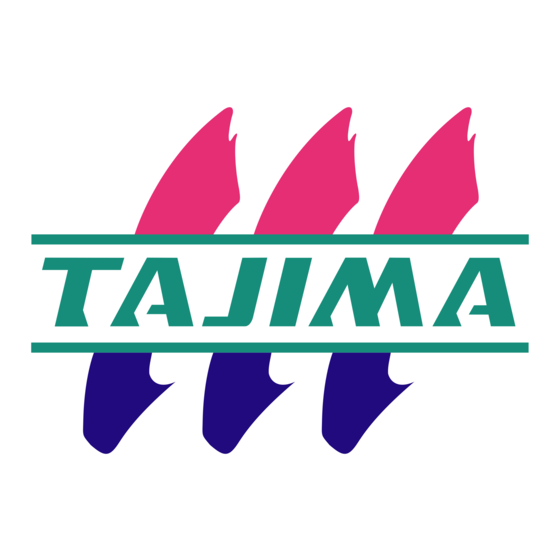
Table of Contents
Advertisement
Quick Links
USER 'S MANUAL
TFMX-IIC TYPE-2
TFMX-C
(single head machine)
TWMX-C
TFMX (L)
1. To turn ON the power ..................................................................34
2. Thread passing, fabric setting......................................................37
3. Registration of a design into the machine memory......................41
5. Decision of the design start position ............................................57
6. Check items before embroidering ................................................64
7. Embroidery starts.........................................................................68
Original Instructions
M-MX47-E
(2020.04)
Advertisement
Table of Contents

Summarization of Contents
Chapter 1 Items That Must Be Followed Carefully
Safety Precautions
Essential safety guidelines and warnings to prevent accidents and damage during operation.
Important Warning Items for Safe Operation
Critical safety instructions for electrical safety, burns, fire, and injury prevention.
Warning Labels
Identifies and explains various warning labels affixed to the machine for safe operation.
Inspection Before Starting Work
Pre-operation checks including cleaning, lubrication, and part inspection for safe and efficient work.
Chapter 2 Name and Way to Use of Each Part
Name of Each Part
Identifies and illustrates the main components of the TFMX-C, TWMX-C, TFMX-IIC, and TFMX (L) machines.
How to Use Each Part
Explains the operation of key machine components like the operation panel, sleep mode key, and emergency stop switch.
Chapter 3 Screen
Screen Display
Details the main screen interface, including design information, stitch counts, and machine settings.
Message Display
Explains various messages displayed by the machine, including condition data and operational prompts.
Chapter 4 How to Perform Embroidery
To Turn ON the Power
Step-by-step instructions and safety precautions for powering on the embroidery machine.
Thread Passing, Fabric Setting
Detailed guide on correctly threading the machine and setting the fabric in the embroidery frame.
Registration of a Design into the Machine Memory
Procedures for loading embroidery designs into the machine memory via USB or PC.
Decision of the Design Start Position
Methods for checking design size and setting the starting point for accurate embroidery.
Chapter 5 Functions Concerning Embroidery
To Change Color
Manual procedure for changing the needle bar color for embroidery designs.
To Trim Thread
Options for manual and automatic thread trimming, including sensitivity settings.
To Stop the Machine
Configuring automatic machine stops based on preset values like stitch count or frame limits.
To Adjust Finishing of Embroidering
Adjusting stitch length, backlash, auto jump, and other parameters for improved embroidery finish.
Chapter 6 Functions Concerning Frame Movement
To Return the Frame (Frame Back) / Advance the Frame (Frame Forward)
Controls for moving the frame backward or forward to return to previous stitches or advance.
Necessary Works After Replacing the Frame
Procedures required after replacing the embroidery frame, including changing frame type and origin memory.
To Return the Frame to the Original Position
Functions for returning the frame to its initial or previous position, including manual offset and power resume.
To Move the Frame to the Position Registered
Automatic frame movement settings for start/end of embroidery and during operation for applique.
Chapter 7 Function Concerning Storing and Deleting of Design
Design Stored in the Machine Memory
Operations for managing designs stored in the machine memory, including deleting, moving, and copying.
Design Saved in USB Memory
Procedures for deleting and sorting designs stored on a USB memory device.
Chapter 8 Setting for Optional Device
To Make Optional Device Available for Use
Settings for enabling optional devices like Sequin, Lubrication, Network, Lochrose, Cording, Boring, and Bobbin Changer.
To Set Details of Optional Device
Detailed configuration for optional devices, including Sequin device settings and Lochrose counter.
Functions Concerning Optional Device
Optional device functions like Air Pressure Sensor, Sequin device data conversion, and Lochrose counter.
Chapter 9 Countermeasure When Some Trouble Occurs in the Machine
Countermeasure When the Machine Stopped
Procedures for restoring the machine after normal or abnormal stops due to various codes.
Trouble Examples and Corrective Actions
Common causes and solutions for issues like thread breakage, needle breaks, and poor sewing finish.
Chapter 10 Maintenance and Inspection
Items That Must Be Followed Carefully
Critical safety and maintenance guidelines, including warnings about high voltage and proper servicing.
Cleaning
Procedures for cleaning specific machine parts like ATH, rotary hook, head, and drive system.
Lubrication
Guidelines for lubricating key machine components such as the rotary hook and inside of the head.
Inspection, Repair
Procedures for regular inspection, safety precautions before repair, and using genuine parts.
Chapter 11 Appendix
Spec. of the Machine
Technical specifications including power supply, noise level, and input voltage switching.
Function Code
Lists editable and non-editable function codes used for machine operations and design data.
Electrical System Diagram
Illustrates the electrical connections for single-head and multi-head machine configurations.
Terminology
Glossary of terms used in the manual, explaining technical concepts and machine parts.



Need help?
Do you have a question about the TWMX-C and is the answer not in the manual?
Questions and answers